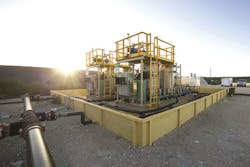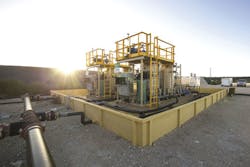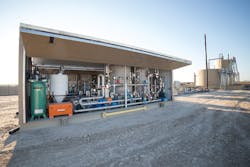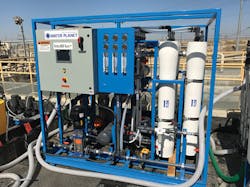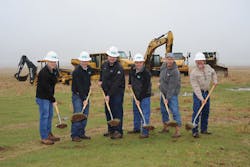Water Management Poised for Growth in Hydraulic Fracturing Sector
Limitations on deep-well injection will help drive more flowback and produced water reuse, experts say
By Jeff Gunderson
The 2014-2015 crash in oil prices and subsequent contraction in hydraulic fracturing activity forced producers to tighten capital spending and scale back their water management programs, adopting cost-cutting measures with regard to water treatment, water transport, and disposal. Approaching the midpoint of 2017, production is still lackluster and many of the cost-saving water strategies utilized during the downturn are still widely in use. But experts also see new opportunities emerging and expect the market for water treatment in unconventional oil and gas production to strengthen in the years to come, driven in large part by more environmental regulation.
According to Wastewater Treatment Technologies in Natural Gas Hydraulic Fracturing, a report by Navigant Research examining the market for hydraulic fracturing wastewater treatment and recycle systems including deep-well injection, a greater emphasis is emerging on water protection through regulations and public efforts. This trend is expected to influence water sourcing and disposal and will increasingly emphasize treatment and recycling of flowback and produced water over deep-well injection, the report found.
“The market for hydraulic fracturing wastewater treatment is certainly going to grow over the next decade, gradually replacing deep-well injection,” said Anne Wrobetz, research analyst with Navigant Research. “This market will grow primarily in the United States and Canada because of regulatory pressure and because of large shale gas reserves.”
Devesh Mittal, vice president and general manager of Aquatech’s Shale Gas Division, said water management strategies are focused on storage, filtration, metals treatment, and sourcing water across producers. While states are introducing regulations to monitor deep-well injection and to promote recycling of produced and flowback water, the market for water treatment is still slow to bounce back from the downturn. “The number of rigs deployed is constantly rising, but water treatment services demand is picking up slower than rig counts,” he said.
Continued Focus on Cost
In the aftermath of the energy price decline, cost reductions across field operations including water management were necessary measures for producing oil at lower prices. Today’s water management strategies continue to be driven by a cost-saving mentality. “The predominant overarching trend in the industry is still dominated by ways to reduce the total spend on water - whether through recycling or sourcing water for lower cost,” Mittal said.
Todd Whiting, vice president of operations with Purestream Services, said producers recognize the efficiencies that were achieved during the downturn and are actively building that experience into their water plans today and for the future.
“Producers discovered innovative ways of saving money when it was necessary to become lean to survive, and as they prepare to drill new wells, they are prioritizing cost-efficient water management strategies and systems up front,” Whiting said. “Rather than implementing water treatment as an afterthought, producers are incorporating well-planned programs covering water sourcing, treatment, and reuse into the overall management plan, which saves both time and money in the long run.”
Setting the Stage for Reuse
Reuse of flowback and produced water is anticipated to play an increasingly larger role in the hydraulic fracturing market, driven by regulations, water scarcity, and economic factors.
“Many producers, especially in West Texas, are limited on the amount of freshwater they can source for new wells and are adopting reuse policies for produced water to provide all or part of the water they need for drilling,” Whiting said. “We believe reuse will trend higher as production in the U.S. begins to increase. In many parts of the country it’s becoming more difficult to obtain permits to drill new injection wells, which makes disposal of produced water increasingly challenging.”
Eric Hoek, CEO of Water Planet, said opportunities for treatment and reuse are greater in regions where water demand for production activity intersects with water scarcity and competing uses such as agriculture. “Those scenarios exist in California, New Mexico, Wyoming, and we’re starting to see some evidence of this mounting in Texas,” he said.
“Another driver for treatment and reuse is the closure of hundreds of injection wells in California because the underlying formations were reclassified as potential drinking water sources,” Hoek said.
But with completion activity in the market still limited, the opportunity for reuse remains hindered. “Reuse is the most viable in multi-well completions, where producers can use the flowback from one well to frack the next, and so on,” Hoek said. “However, the current market dynamics do not support this level of production. Reuse now is more likely to require storage and transportation, which increases costs and makes the logistics problematic.”
Emerging Opportunities
Although production numbers are low, Hoek said opportunities can still be found in the unconventional space, with more beginning to appear. “We’re seeing activity developing in New Mexico’s Delaware Basin, where considerable investments have been made in pipeline infrastructure to move water more cost-effectively,” Hoek said. “In that region, opportunities are available to treat flowback and produced water so that it can be conveyed through the network to other frack jobs for reuse. The availability of that distribution system is spurring new investments in drilling and completions.”
In what could be considered evidence of more imminent activity, ExxonMobil earlier this year took a large position in shale, agreeing to a deal worth as much as $6.6 billion to buy companies with drilling rights in the Permian Basin of Texas and New Mexico.
“Exxon has started to increase its capital budgets, which will begin to really roll out next year,” Hoek said. “Other companies are following suit. And there is currently a lot of pilot investing for evaluating technologies that will be implemented at full scale in 2018 or 2019.”
About the Author: Jeff Gunderson is a correspondent for Industrial WaterWorld. He is the founder of Waterstone Writing (waterstonewriting.com), a specialized content provider with a core focus in water, technology, energy and sustainable solutions. Jeff is also a part-time faculty instructor at Portland State University, teaching in the Professional and Technical Writing program. He holds a master’s degree in Environmental Science and Engineering from the Colorado School of Mines and a bachelor’s degree in General Science from the University of Oregon.
New Water Recycling Facility Underway for Newfield Exploration
In late March, Newfield Exploration Company (NYSE: NFX) broke ground on a water recycling facility located in its STACK play in the Anadarko Basin (Kingfisher County, Okla.). The complex, named the Barton Water Recycle Facility, is expected to process approximately 30,000 barrels of water per day (BWPD) upon completion early in the third quarter of 2017.
“The new Barton facility will be capable of recycling both the flowback and produced water currently generated from our STACK wells and hydraulic fracturing operations,” said Newfield Chairman Lee K. Boothby. “Today’s innovative technologies are allowing us to more cost-effectively recycle and reuse the water we produce from our operations. This is good for our economics and good for the environment,” added Boothby.
The Barton facility will utilize aerated biologic treatment technology to convert produced water into recycled water for hydraulic fracturing operations. The treatment process uses natural and enhanced bioremediation, or good bacteria and nutrients, to separate and break down any existing impurities that may be contained in the produced water. The end result is a high-quality water primarily free of impurities - very similar to what is initially found in the reservoir rock.
“The time when the procurement and disposal of water in oil and gas operations was viewed as routine is over,” said Chairman Dana Murphy, Oklahoma Corporate Commission. “Water has now become an absolutely critical component that demands careful planning for environmental, conservation and business reasons. This facility is a step in the continuing evolution of the industry.”
Newfield has invested more than $40 million to date in water management infrastructure in its STACK play. The new recycling facility is a multimillion-dollar investment located on a 30-acre site and will connect to seven pits with nearly 6.5 million barrels of storage capacity utilizing more than 70 miles of underground pipeline by the end of 2017.
